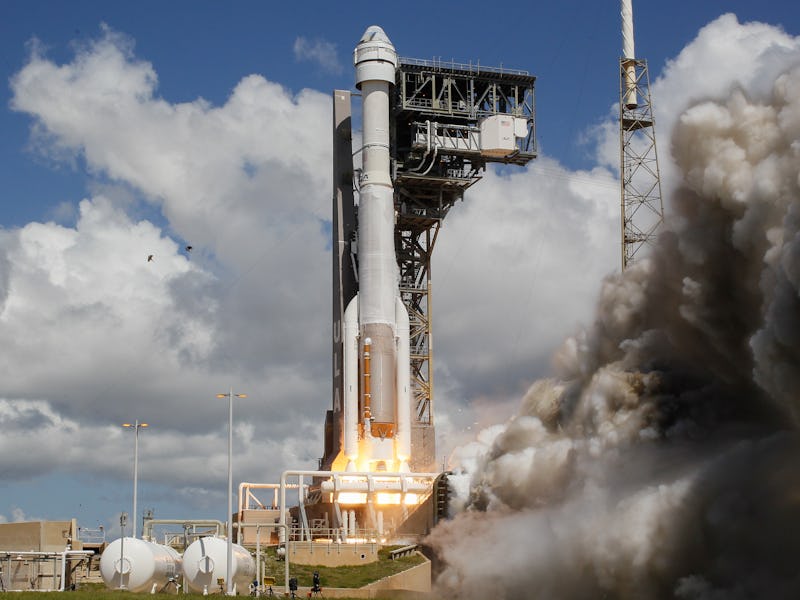From Urine (Yes, Urine) to Helium: The Most Common and Bizarre Leaks During Space Travel
Hours after Starliner launched, teams detected helium leaks on several of the spacecraft’s thrusters.

The Boeing Starliner will return to Earth no earlier than June 22, a four-day delay from its previous target date. Helium leaks, discovered once Starliner was in space, may be part of the reason for the delay.
Hours after Starliner launched, teams detected helium leaks on several of the spacecraft’s thrusters. One was known about before launch. The other four were unexpected. NASA reports that the spacecraft has enough helium to carry astronauts Butch Wilmore and Suni Williams the seven hours it takes to return to Earth after undocking from its current location at the International Space Station (ISS).
“Engineers evaluated the helium supply based on current leak rates and determined that Starliner has plenty of margin to support the return trip from [the] station,” NASA officials wrote in a blog post published on Monday.
Starliner is currently on its first crewed demonstration flight to certify the vehicle so it can join the space agency’s Commercial Crew Program fleet.
Leaks happen in space travel. When they’re caught before launch, teams assess whether to call off the flight to intervene, or to allow the vehicle to fly. But once in space, that choice is taken away. Various procedures, such as abort systems, allow for early intervention if an anomaly during liftoff is life-threatening. Once in space, astronauts attempt to find a solution, whether it is a propellant leak, urine at the bottom of the spacecraft, or dangerous ammonia coolant.
Urine (yes, urine) Leaks
At least twice, SpaceX Crew Dragons have sprung urine leaks. As Business Insider reported, the first occurred during a short trip, the Inspiration4 mission in 2021. The wastewater released below the cabin floor, and fell on top of a fan critical to producing toilet suction in microgravity. The leak was confirmed once the capsule was back on Earth.
More concerning, a urine leak happened during the six-month Crew-2 mission. With the spacecraft being docked at the orbiting laboratory for half a year, this meant the urine was there for a long period of time.
Coolant leaks
Between the end of 2022 and early 2023, Russian spacecraft and station segments suffered coolant leaks. First, a passenger spacecraft called Soyuz MS-22 sprung a dramatic coolant leak, captured by ISS feed cameras. An investigation determined the likely culprit was the impact from a micrometeoroid. The spacecraft was deemed too risky to be used to return the three astronauts that flew up to space onboard it a few months earlier, and Russia deorbited the Soyuz with no one onboard. The three astronauts remained on the station for more than one year, and boarded a new Soyuz capsule to return home. Astronaut Joe Acaba now holds the NASA record for longest single spaceflight as a result of that fiasco.
Ammonia and hydrogen leaks
As Space.com reported, toxic ammonia flakes from a leaking backup radiator appeared in the Russian Nauka Multipurpose Laboratory Module of the ISS. Ammonia is used to cool down the station as it warms up due to waste heat from the station systems. Though the ammonia is toxic, NASA said astronauts were never in any danger.
In 1999, the Space Shuttle Columbia suffered a hydrogen leak when a pin came loose during liftoff and weakened three cooling tubes that eventually ruptured. CNN reported that this caused the right main engine to run 100 degrees warmer, using more propellant. If the leak had been worse, the engine may have shut down, and trigger an abort maneuver that hadn’t been tried yet. The mission was unaffected, however, and the five-day mission went on as planned.
Leaks currently ongoing in space
In addition to the Starliner leak, the Russian segment of the ISS has been leaking air into space. As the Washington Post reported, the solution was to isolate the leak by closing a hatch there. NASA reports there’s no impact at the moment on crew safety, but that they are working with Russian officials to find a solution.
As for Starliner, NASA will provide an update to the spacecraft’s status on Tuesday.